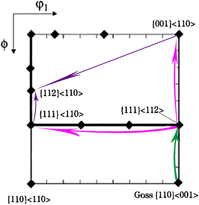Article contents
Effects of warm rolling reduction on the microstructure, texture and magnetic properties of Fe–6.5 wt% Si steel
Published online by Cambridge University Press: 10 May 2016
Abstract

As the core materials with excellent soft magnetic properties, Fe–6.5 wt% Si steel was fabricated by using the warm rolling process due to its extremely limited ductility and formability at room temperature. In this work, the effects of warm rolling reduction varying from 50% to 85% on the microstructure, texture, and magnetic properties of sheets were explored. The microstructure and texture evolution at the various processing steps were investigated in detail using optical microscopy, electron backscatter diffraction, and transmission electron microscopy. The results demonstrate that the finer recrystallization grains are accompanied with an increasing warm rolling reduction, and the final annealed sheets are characterized by strong α-fiber and γ-fiber textures. Accordingly, on the whole, as the increase of warm rolling reductions, the values of magnetic induction (B8, B50) in the final annealed sheets increase sharply up to a maximum value and then decrease to a certain value, and the values of iron loss (P15/50, P10/400) increase monotonically.
- Type
- Articles
- Information
- Copyright
- Copyright © Materials Research Society 2016
References
REFERENCES
- 3
- Cited by



